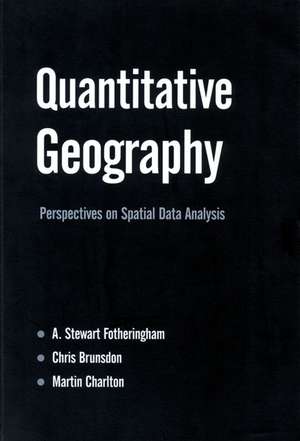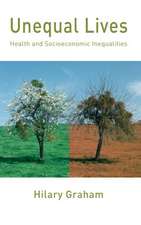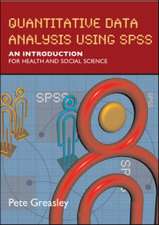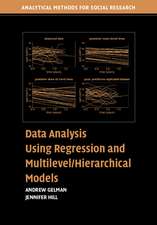Quantitative Geography: Perspectives on Spatial Data Analysis
Autor A Stewart Fotheringham, Chris Brunsdon, Martin Charltonen Limba Engleză Hardback – 12 ian 2000
`This is a veritable tour de force of everything that is exciting about quantitative geography and GIS. It is a timely, thorough and exciting account of the state of the art and science of spatial analysis' - Paul Longley, University of Bristol
`A highly innovative and up-to-date text. It is unique in its coverage of the many developments that have taken place in the field over the past few years. The book is one that is highly readable and stimulating for those with some background in the field, and its expositional style and many examples will make it stimulating to newcomers as well' - Peter Rogerson, State University of New York at Buffalo
`Brings the field thoroughly up to date, integrating modern methods of GIS with a comprehensive and easy-to-read overview of the most recent and powerful techniques of spatial analysis. The book will be valuable to students and researchers in any discipline that seeks to explore or explain phenomena in geographical context, and will make excellent reading for geographers, political scientists, criminologists, anthropologists, geologists, epidemiologists, ecologists, and many others. It offers a spirited challenge to critics of a scientific approach to social science, and demonstrates the value of its subject matter through abundant examples' - Michael Goodchild, National Center for Geographic Information and Analysis, University of California, Santa Barbara
`There is a view within some parts of academic geography that what used to be called "quantitative geography" is dead, having been subsumed within "geographical information systems" or else of no continuing interest. This book should correct this view. First, it shows that quantitative methods have remained an exciting area of development and, second, it shows that, if anything, they have more relevance to substantive problems of interest than they have ever had. Although not specifically about GIS, it is a book that should be read by everyone concerned with the analysis of geographical information' - David Unwin, Birkbeck College, University of London
| Toate formatele și edițiile | Preț | Express |
|---|---|---|
| Paperback (1) | 654.35 lei 6-8 săpt. | |
| SAGE Publications – 10 ian 2000 | 654.35 lei 6-8 săpt. | |
| Hardback (1) | 1267.37 lei 6-8 săpt. | |
| SAGE Publications – 12 ian 2000 | 1267.37 lei 6-8 săpt. |
Preț: 1267.37 lei
Preț vechi: 1545.57 lei
-18% Nou
Puncte Express: 1901
Preț estimativ în valută:
242.50€ • 253.88$ • 200.66£
242.50€ • 253.88$ • 200.66£
Carte tipărită la comandă
Livrare economică 07-21 aprilie
Preluare comenzi: 021 569.72.76
Specificații
ISBN-13: 9780761959472
ISBN-10: 0761959475
Pagini: 288
Ilustrații: maps
Dimensiuni: 170 x 242 x 21 mm
Greutate: 0.62 kg
Ediția:First Edition
Editura: SAGE Publications
Colecția Sage Publications Ltd
Locul publicării:London, United Kingdom
ISBN-10: 0761959475
Pagini: 288
Ilustrații: maps
Dimensiuni: 170 x 242 x 21 mm
Greutate: 0.62 kg
Ediția:First Edition
Editura: SAGE Publications
Colecția Sage Publications Ltd
Locul publicării:London, United Kingdom
Recenzii
`This is a veritable tour de force of everything that is exciting about quantitative geography and GIS. It is a timely, thorough and exciting account of the state of the art and science of spatial analysis' - Paul Longley, University of Bristol
`A highly innovative and up-to-date text. It is unique in its coverage of the many developments that have taken place in the field over the past few years. The book is one that is highly readable and stimulating for those with some background in the field, and its expositional style and many examples will make it stimulating to newcomers as well' - Peter Rogerson, State University of New York at Buffalo
`Brings the field thoroughly up to date, integrating modern methods of GIS with a comprehensive and easy-to-read overview of the most recent and powerful techniques of spatial analysis. The book will be valuable to students and researchers in any discipline that seeks to explore or explain phenomena in geographical context, and will make excellent reading for geographers, political scientists, criminologists, anthropologists, geologists, epidemiologists, ecologists, and many others. It offers a spirited challenge to critics of a scientific approach to social science, and demonstrates the value of its subject matter through abundant examples' - Michael Goodchild, National Center for Geographic Information and Analysis, University of California, Santa Barbara
`There is a view within some parts of academic geography that what used to be called "quantitative geography" is dead, having been subsumed within "geographical information systems" or else of no continuing interest. This book should correct this view. First, it shows that quantitative methods have remained an exciting area of development and, second, it shows that, if anything, they have more relevance to substantive problems of interest than they have ever had. Although not specifically about GIS, it is a book that should be read by everyone concerned with the analysis of geographical
information' - David Unwin, Birkbeck College, University of London
`A highly innovative and up-to-date text. It is unique in its coverage of the many developments that have taken place in the field over the past few years. The book is one that is highly readable and stimulating for those with some background in the field, and its expositional style and many examples will make it stimulating to newcomers as well' - Peter Rogerson, State University of New York at Buffalo
`Brings the field thoroughly up to date, integrating modern methods of GIS with a comprehensive and easy-to-read overview of the most recent and powerful techniques of spatial analysis. The book will be valuable to students and researchers in any discipline that seeks to explore or explain phenomena in geographical context, and will make excellent reading for geographers, political scientists, criminologists, anthropologists, geologists, epidemiologists, ecologists, and many others. It offers a spirited challenge to critics of a scientific approach to social science, and demonstrates the value of its subject matter through abundant examples' - Michael Goodchild, National Center for Geographic Information and Analysis, University of California, Santa Barbara
`There is a view within some parts of academic geography that what used to be called "quantitative geography" is dead, having been subsumed within "geographical information systems" or else of no continuing interest. This book should correct this view. First, it shows that quantitative methods have remained an exciting area of development and, second, it shows that, if anything, they have more relevance to substantive problems of interest than they have ever had. Although not specifically about GIS, it is a book that should be read by everyone concerned with the analysis of geographical
information' - David Unwin, Birkbeck College, University of London
Cuprins
Establishing the Boundaries
Spatial Data
The Role of Geographic Information Systems
Exploring Spatial Data Visually
Local Analysis
Point Pattern Analysis
Spatial Regression and Geostatistical Models
Statistical Inference for Spatial Data
Spatial Modelling and the Evolution of Spatial Theory
Challenges in Spatial Data Analysis
Spatial Data
The Role of Geographic Information Systems
Exploring Spatial Data Visually
Local Analysis
Point Pattern Analysis
Spatial Regression and Geostatistical Models
Statistical Inference for Spatial Data
Spatial Modelling and the Evolution of Spatial Theory
Challenges in Spatial Data Analysis
Descriere
Integrating a discussion of the application of quantitative methods with practical examples, this book explains the philosophy of the new quantitative methodologies and contrasts them with the methods associated with geography's `Quantitative Revolution' of the 1960s. Key issues discussed include: the nature of modern quantitative geography; spatial data; geographical information systems; visualization; local analysis; point pattern analysis; spatial regression; and statistical inference. Concluding with a review of models used in spatial theory, the authors discuss the current challenges to spatial data analysis.
Written to be accessible, to communicate the diversity and excitement of recent thinking, Quantitative Geog













